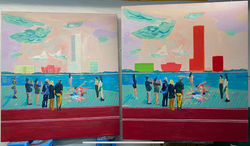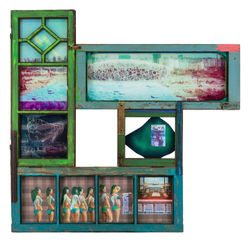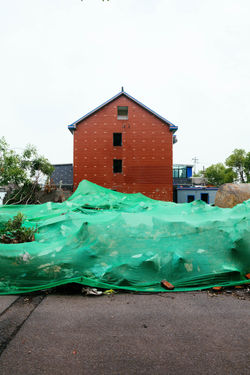Tang Contemporary Art is proud to announce the opening of Li Qing’s solo exhibition “Lighthouse and Cradle”, held in both of the gallery’s Beijing spaces on September 12. Curated by Cui Cancan, the exhibition will showcase Li Qing’s important series “Window”, “Spot the Difference”, “Images of Mutual Undoing and Unity”, “Hangzhou House”, as well as his most recent work from 2021.
The Lighthouse and the Cradle
The “lighthouse” and the “cradle” come from imagery found in the works of Li Qing, and are symbols for Utopia in literature. The exhibition takes “the lighthouse and the cradle” as a starting point and point of embarkation between multiple series, as metaphors for ideals and arrival, as it takes a new look at the continuous stories that have unfolded in Li Qing’s works since 2005.
The exhibition is divided into two parts. In an architectural space rendered in the Bauhaus style, symbolizing the cradle of modern design, a temporary tent appearing like a light swaying over the surface of the sea becomes the focus, or bonfire, at the center of the two spaces. Works from the three series “Spot the Differences,” “Mutual Undoing,” and “Windows” surround the space to the right and left, becoming background noise that leads to reality. A carpet in the ruins of an old house, a kitschy Hangzhou building in a mixture of styles, faces in magazines, the artist’s travels, and two giant group portraits of discarded refrigerators draw the gaze to a circuitous, overlapping world. Here, image, sign and reality intertwine, conceal and alternate between one another.
Two worlds, one with maze-like nested chambers carrying a monumental grand narrative, the cradle of Bauhaus, and metaphors of Ilya Kabakov flying into space; the other a multilevel space connected by arches, pulsing with the drifting dust of ruins, the smooth aesthetic of reality, glossy landmark buildings, and a yellow tent like a lighthouse in the grass. Mirror images of reality and interchanging representations, the basic traits of Li Qing's art, thread throughout.
As a leading representative of the new generation painters, Li Qing’s creative thread and field of vision are extraordinarily rich. Unlike his peers, his painting no longer focuses on working within the four corners of the picture, but instead constantly expands painting’s external space and ways of seeing. In the “Spot the Differences” series, two similar pictures turn seeing into recognition. Which painting is closer to the truth? What is the relationship between painting, with its realist tradition, and reality today? Seeing and truth have become themes of our time. The questioning continues in the “Mutual Undoing” series, where two intertextual images become one in an entirely new picture. The stacked result is further from the truth, resulting in a “reconstruction” that is neither one nor the other. Reconstruction and representation point to the mysteries of painted expression, and the significance of rhetoric.
As an imagining and metaphor for the outside world, the window is the best carrier for "representation.” In Li Qing's works, window frames and lattices become part of the structure of the picture, with the wear and tear of the old windows fusing together with the paint and brushwork. Windows are the landscape of the city, carrying stories, restoring hope, dividing distances. Every window has implications of class and power. In his newest works, Li Qing no longer continues the literary character of his past works, or the discussion of time and space. The window returns to itself, referencing the existential relationship between itself, architecture and the city. The structure of the window frame forms a stark contrast with the smooth aesthetics and glossy landmark buildings of the picture. Painting has returned to reality, to a radical aesthetic.
Language never exists in isolation. The uninterrupted experimentation and sustained momentum across these various series are outgrowths of the themes Li Qing has been following since 2005: information and image in the technological age, the social mechanisms and power dynamics of seeing, the relationship between people, architecture and the city amidst globalization, the patterns and disciplining of aesthetics in the consumer age. Between the lofty towers and the swaying tent, the literary implications between the “lighthouse and the cradle” begin to fade and become the antithesis of Utopia.
Curator: Cui Cancan
 Surface Science No.4Mixed Media 60 x 80 x 11 cm 2019 |  A Spa Odyssey 2021Antique wooden window, oil paint, acrylic, canvas, plexiglass 158 x 94 x 10 cm 2021 |  Fulcrum MovementWood, Canvas, plexiglass, oil Color, acrylic, inkjet print, aluminium-plastic panel 150 x 200 x 6 cm 2017 |
|---|---|---|
 Green Faces-EY867Fabric mounted on wooden board, printed matters, acrylic, markers, oil-absorbing sheets, grease from human faces 100 x 70 x 3.5 cm 2021 |  Green Faces · Six WomenWooden board, fabric, acrylic, printed matters, photo, oil-absorbing sheets, grease from human faces 45 x 45 x 4 cm 2020 |  Green Faces - AF0116Wooden board, fabric, printed matters,oil-absorbing sheets, grease from human faces 200 x 150 x 5 cm 2020 |
 Dark Magazine· CanvasMagazine Wrapped with Brocade 29.8 x 23.8 x 1.9 cm 2020 |  Dark Magazine· CanvasMagazine Wrapped with Brocade 29.7 x 23.6 x 1.8 cm 2020 |  Front Desk 2021Antique wooden window, oil paint, canvas, plexiglass, frame, aluminium-plastic panel 107 x 170 x 5 cm 2021 |
 IthacaOil paint, aluminium plate, canvas 70 x 55 x 6 cm 2021 |  (ground)Things You Can Take Away9 printed nylon carpets Dimension variable 160 x 240 cm、160 x 240 cm、180 x 240 cm、180 x 240 cm、 180 x 300 cm、180 x 300 cm、240 x 300 cm、240 x 360 cm、300 x 400 cm 2019 |  WestbundOil on canvas 200 x 180 cm x 2 each 2021 |
 The Birth of BeautyOil on canvas 110 x 150 cm 2021 |  Tetris Window · Exhibition CenterWood, metal, plexiglass, oil color, clothes, printed matters, photos, Aluminium-plastic panel 212.5 x 106 x 10 cm 2019 |  Neighbor's Window · Decorated EggsAntique wooden window, oil paint, plexiglass 157 x 94 x 10 cm 2021 |
 Neighbor's Window · Hangzhou CITIC Bank Building (Norman Foster)Antique wooden window, oil paint, pad painting, UV printing, plexiglass 159 x 94.5 x 9 cm 2021 |  Neighbor's Window· Hangzhou Yin (Bauhaus Boat)Antique wooden window, oil paint, pad painting, UV printing, plexiglass 158 x 93 x 9.5 cm 2021 |  Rear Window · S/TOPAntique wooden window, oil paint, plexiglass 189.5 x 101 x 5.5 cm 2020 |
 Black Group PortraitOil on canvas 240 x 200 cm x 3 each 2010 |  White Group PortraitOil on canvas 240 x 200 cm x 3 each 2010 |  One CenturyAntique door, oil color, plexiglass, aluminium-plastic panel 225.5 x 58.5 x 6 cm 2020 |
 Curve and StraightWood, metal, plexiglass, oil paint, oil pastel, printed matters, curling iron, aluminium-plastic panel 124.5 x 120.5 x 7 cm 2017-2018 |  Brancusi ApartmentsOil on Canvas 65 x 80 x 3 cm 2021 |  Rear Window · Colorful StonesAntique wooden window, oil paint, plexiglass 158 x 94 x 10 cm 2021 |
 View From The Pangu HotelWooden, metal, plexiglass, oil paint, acrylic, spray paint, markers, clothes, printed matters 136 x 140 x 6.5 cm 2017-2019 |  Spot the Difference · Sales Lady(There are 5 differences in the two paintings)Oil on canvas 200 x 150 cm x 2 each 2019 |  Images of Mutual Undoing and Unity · Body AestheticsPhoto、 Oil on canvas 180 x 140 cm x 2 each( 2 photo variable size) 2021 |
 The Human Baby Who Flew Into Space From The Cradle of Bauhaus or KabakovOil and acrylic on canvas 240 x 180 cm x 2 each 2021 |  Spot The Difference · Rear Windows(There are 6 differences in the two paintings)Oil on canvas 160 x 120 cm x 2 each 2019-2020 |  AranyaOil on canvas 80 x 65 x 3.5 cm 2021 |
 Hangzhou House No.65Collectible inkjet printing 90 x 60 cm,5+2AP 2019 |  Hangzhou House No.66Collectible inkjet printing 90 x 60 cm,5+2AP 2019 |  Messenger No.1Oil on canvas 57 x 32 cm 2021 |
 Messenger No.2Oil on canvas 41 x 44 cm 2021 |  Messenger No.3Oil on canvas 50 x 35 cm 2021 |  Messenger No.4Oil on canvas 43 x 57 cm 2021 |
 Messenger No.5Oil on canvas 60 x 48 cm 2021 |  Messenger No.6Oil on canvas 54.5 x 68 cm 2021 |  Messenger No.7Oil on canvas 57 x 27.5 cm 2021 |
Artist

Li Qing
Li Qing was born in Huzhou, Zhejiang Province in 1981. He lives and works in Hangzhou and Shanghai. His paintings, installations and video works seek rational rifts in similarity and contradiction, acting on the perception and acknowledgment of a viewer through circuitous and overlapped structures. In recent years, his works track the historical fragmentation and ideological conflicts that have occurred widely in the dissemination of information, collective memory, and knowledge experience. Simultaneously, his works are testing the tension and contradiction between image, language, symbol and social space, connecting the multi-level elements of experience in series to construct a conflict structure. The capture of micro-politics in everyday spaces and images, the questioning of political identity in aesthetic tradition, and the observation on the identity of Chinese Art in the context of Global Art, all reflect his historical consciousness among the younger generation of Chinese artists.
He has been living in Kunming with parents since 1956, and graduated from the Yunnan Art Academy in 1982. Mao Xuhui is an iconic artist in Chinese contemporary art history. He is one of the figures in China Art Power 100 and the leader of the avant-garde community in southwest China in the 1980s. Between 1985 and 1989, he brought together a host of young artists mostly from Yunnan and Sichuan under the banner of “New Figurative” to form the Southwest Art Research Group, whose members represented and celebrated in their paintings such intense life awareness typical of the southwestern regions of China that the group came to represent a significant part of the ’85 New Wave, a vanguard movement of contemporary Chinese art. These achievements have earned him a crucial position in Chinese contemporary art history.
Mao Xuhui has widely exhibited in Euro-pan-Asian cities, including Shanghai, Beijing, Hong Kong, Singapore, New York, San Francisco, Barcelona, Bologne, Paris, and London. His artworks are included in many influential exhibitions, for example, the milestone exhibition in Chinese contemporary art history, Inside Out: New Chinese Art (1998) co-organized by Asia Society New York, Museum of Modern Art, San Francisco and Hong Kong Museum of Art. His works have been collected by prominent domestic and international galleries and museums, publicized worldwide by news media, and published in art history books and academic journals.
Curator

Cui Cancan
Cui Cancan is an active Chinese independent curator and critic.
He has won CCAA (Chinese Contemporary Art Award) Art Review Award for Youth, Critics’ Award in Chinese contemporary art by YISHU, Annual Exhibition Award by Art Power 100, Nominee for Lincoln Curator Prize by TANC Asia Prize, The Best Artist Solo Exhibition of the Year Award by Chinese Contemporary Art News, Best Exhibition Award by Gallery Week Beijing, Annual Curator Award by Art Bank, et cetera.
Since 2012, he has curated almost 100 major exhibitions, including group exhibitions like Hei Qiao Night Way (2013), Rural Wash, Cut and Blow-dry(2013), FUCKOFF II (2013), Unlived by What is Seen (2014), Between the 5th and 6th Ring Road in Beijing (2015), The Decameron (2016), Rip it Up (2017), Spring Festival Projects (2018) , The Curation Workshop (2019) and Nine-Tiered(2020). He has curated artists’ solo exhibitions such as Ai Weiwei, Bao Xiaowei, Chen Danqing, Chen Yufan, Chen Yujun, Feng Lin, Han Dong, He Yunchang, Huang Yishan, Jiang Bo, Li Binyuan, Liu Gangshun, Liu Jianhua, Li Qing, Li Zhanyang, Ding Muer, Ma Ke, Mao Yan, Qin Qi, Sui Jianguo, Shijiezi Art Museum, Shi Jinsong, Shen Shaomin, Tan Ping, Wang Qingsong, Xie Nanxing, Xia Xiaowan, Xia Xing, Xiao Yu, Xu Zhongmin, Xu Xiaoguo, Zong Ning, Polit-Sheer-Form, Zhang Yue and Zhao Zhao et cetera.



